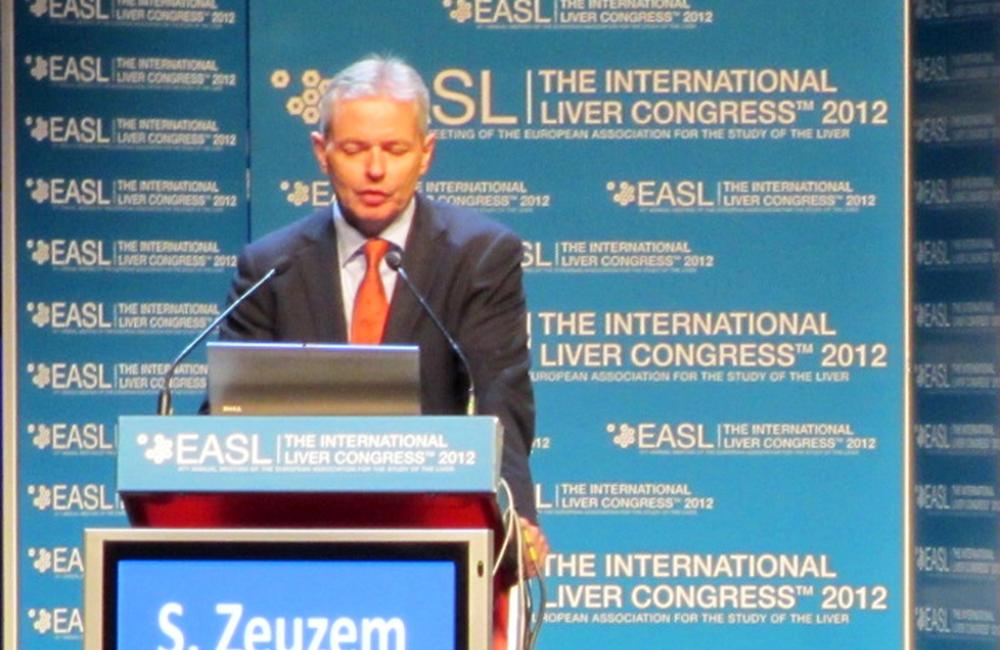
A combination of TMC435 – also known as simeprevir – plus pegylated interferon and ribavirin raised cure rates for genotype 1 hepatitis C patients who did not respond to previous treatment, according to a study presented at the 47th International Liver Congress last week in Barcelona.
Last year's approval of the first direct-acting antiviral agents has changed the face of treatment for chronic hepatitis C, but several potentially more effective and better tolerated next-generation drugs are under development. Those expected to be next in line for approval will be used with pegylated interferon/ribavirin until trials of all-oral therapy are completed.
TMC435 is a potent once-daily hepatitis C virus (HCV) NS3/4A protease inhibitor. Early studies showed potent activity against HCV genotype 1, lesser activity against genotypes 2, 4, 5 and 6, and a favourable safety profile.
In the ASPIRE trial, Stefan Zeuzem from JW Goethe University Hospital and an international team of investigators evaluated TMC435 added to the previous standard-of-care treatment for chronic hepatitis C.
This phase IIb trial included 462 treatment-experienced patients with difficult-to-treat HCV genotype 1. Forty per cent were prior relapsers (undetectable HCV RNA at the end of prior therapy but viral rebound during 24 weeks of post-treatment follow-up), 35% were prior partial responders (at least a 2 log10 viral load reduction at week 12 of prior therapy but still detectable at the end of treatment) and 25% were prior null responders (less than a 2 log10 decrease in HCV RNA by week 12 of prior therapy).
About two-thirds of participants were men, almost all were white, and the median age was 50 years. Just over 40% had HCV subtype 1a, the rest 1b; most had high HCV viral load at baseline. Seventeen per cent had the favourable IL28B 'CC' genotype associated with good response to interferon. Nearly 20% had advanced liver fibrosis (stage F3) and a similar proportion had cirrhosis (stage F4) at baseline. Patients with liver cancer, transplant recipients and HIV or hepatitis B co-infected people were excluded.
Participants were randomly allocated to receive 100mg or 150mg once-daily TMC435 for either 12, 24 or 48 weeks in combination with pegylated interferon alfa-2a (Pegasys) and 1000 to 1200mg/day weight-adjusted ribavirin. In the 12- and 24-week arms, pegylated interferon/ribavirin were continued alone through week 48. The control arm received pegylated interferon/ribavirin plus placebo.
At week 4 of treatment, rapid virological response (RVR) rates among patients receiving 100mg TMC435 were 67%, 59% and 53%, respectively, in the 12-, 24- and 48-week groups. Among people receiving 150mg TMC435, the corresponding rates were 62%, 68% and 66%, respectively. Only 2% of this difficult-to-treat population saw a rapid response with pegylated interferon/ribavirin alone.
RVR was a good predictor of sustained virological response 24 weeks after completion of therapy (SVR24). Sustained response rates were 70%, 66% and 61% for people taking 100mg TMC435 for 12, 24 or 48 weeks, and 67%, 72% and 80% for those receiving 150mg. The SVR rate in the control group was just 23%.
Looking at type of prior response, the SVR24 rates for relapsers were 85% with either 100mg or 150mg TMC435 compared with 37% in the control group. For prior partial relapsers, the corresponding rates were 57%, 75% and 9%, respectively. Rates for prior null responders were 46%, 51% and 19%, respectively.
Among prior relapsers, those with HCV subtype 1a and 1b had similar cure rates, but among prior partial and null responders those with subtype 1b did better. People with minimal fibrosis responded better overall than those with advanced fibrosis or cirrhosis.
Few TMC435 recipients met the stopping rule for discontinuing treatment early due to likely futility, compared with up to 75% of patients taking pegylated interferon/ribavirin alone. Viral breakthrough during treatment occurred in 1% to 24% of TMC435 recipients in the various arms, while viral relapse after completing treatment was seen in 3% to 16%.
As described in another presentation at the conference by Oliver Lenz from Tibotec, viral breakthrough and relapse were usually associated with signature resistance mutations at NS3 positions 80, 122, 155 and/or 168, but the distribution of mutations varied significantly between genotype 1a and 1b.
TMC435 was generally well tolerated. Rates of serious adverse events were 6% in the 100mg TMC435 arm, 10% in the 150mg arm and 6% in the control arm. Rates of discontinuation due to adverse events were 7%, 9% and 5%, respectively.
The most common side-effects across all groups were headache, fatigue and flu-like symptoms. TMC435 recipients were more likely to experience pruritis (itching) or skin rash than those in the control group, but severe rashes were rare (0.5%). Changes in blood cell levels were similar in the TMC435 and control arms. People taking TMC435 were more likely to develop elevated bilirubin, which Zeuzem explained was related to the drug's effect on two transporters.
"In HCV genotype 1 patients who previously failed pegylated interferon/ribavirin treatment, once-daily TMC435 administered with pegylated interferon/ribavirin was significantly more effective than pegylated interferon/ribavirin/placebo", the researchers concluded. "Once-daily TMC435 was well tolerated in this population".
Based on the finding of somewhat better response rates in the higher-dose TMC435 arm – especially for prior partial or null responders – the 150mg dose is currently undergoing testing in phase III clinical trials.
Zeuzem noted that while all arms were treated for a total of 48 weeks in this study, data "clearly indicate that a treatment duration of 12 weeks achieves optimal SVR rates", suggesting that TMC435 will be suitable for response-guided therapy.
Zeuzem S et al. TMC435 in HCV genotype 1 patients who have failed previous pegylated interferon/ribavirin treatment: final SVR24 results of the ASPIRE trial. 47th Annual Meeting of the European Association for the Study of the Liver, Barcelona, abstract 2, 2012.
http://mobile.ilcapp.eu/EASL_161/poster_23749/program.aspx
Lenz O et al. TMC435 in patients infected with HCV genotype 1 who have failed previous pegylated interferon/ribavirin treatment: virologic analyses of the ASPIRE trial. 47th Annual Meeting of the European Association for the Study of the Liver, Barcelona, abstract 9, 2012.
